Upside Down Fire
Wood burning stoves may not be all that common in America (at least in the South where I’m from), but they are in just about every single home in New Zealand. Most homes there are hopelessly uninsulated, but at least most of their heat sources are energy efficient and completely natural.
Drew and I struggled at first to get a roaring fire started in some stoves, but after spending one evening wrapped up in four blankets trying to cook dinner, we did some research. Some advice from different websites definitely helped, but it seemed to take ages of feeding the fire more kindling and blowing on it before it would settle in and burn well.
Even with all the trouble we went through, we’ve known for a while that we would definitely have a wood-burning stove in our future home. The heat is so nice and even a small stove does an excellent job heating up large areas. Plus, on many models you can cook on top of the stove itself, saving even more money on the utility bill.
We recently learned what we’ve concluded is the absolute best way to build a fire in a wood-burning stove. May I present to you the Upside Down Fire:
The Upside Down Fire Method
1. Clear your firebox of all leftover ash and place your biggest logs, as close together as possible, on the bottom.
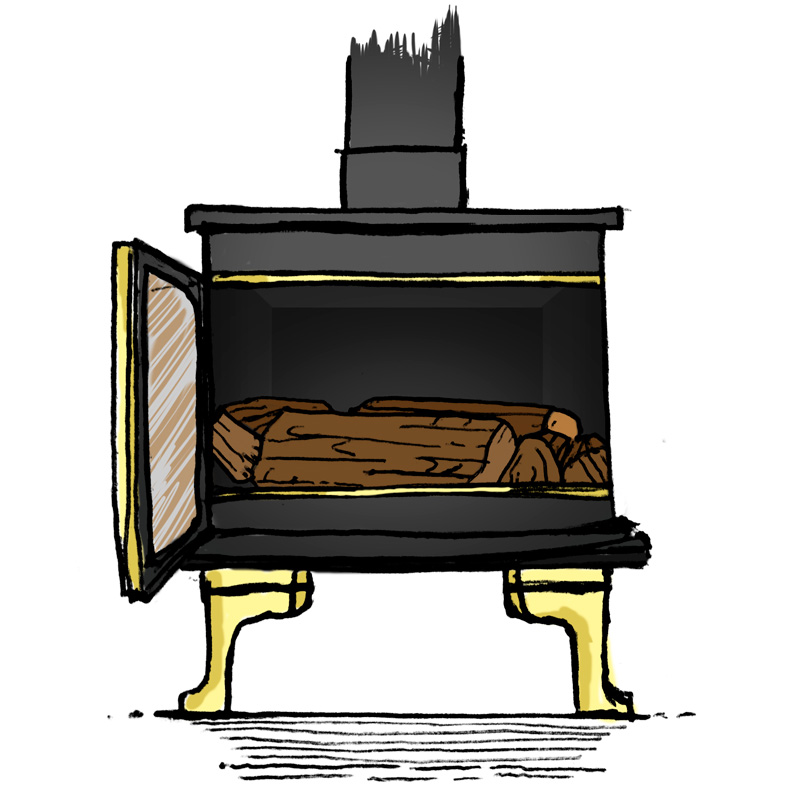 2. Add a layer of smaller logs, then kindling and loosely bunched newspaper–all the way up to the top of the firebox, leaving only a couple inches of space. You can include fire starters if you’d like (Root Simple has a great idea for making your own), but the condition of your wood is more important for getting the fire to light.
2. Add a layer of smaller logs, then kindling and loosely bunched newspaper–all the way up to the top of the firebox, leaving only a couple inches of space. You can include fire starters if you’d like (Root Simple has a great idea for making your own), but the condition of your wood is more important for getting the fire to light.
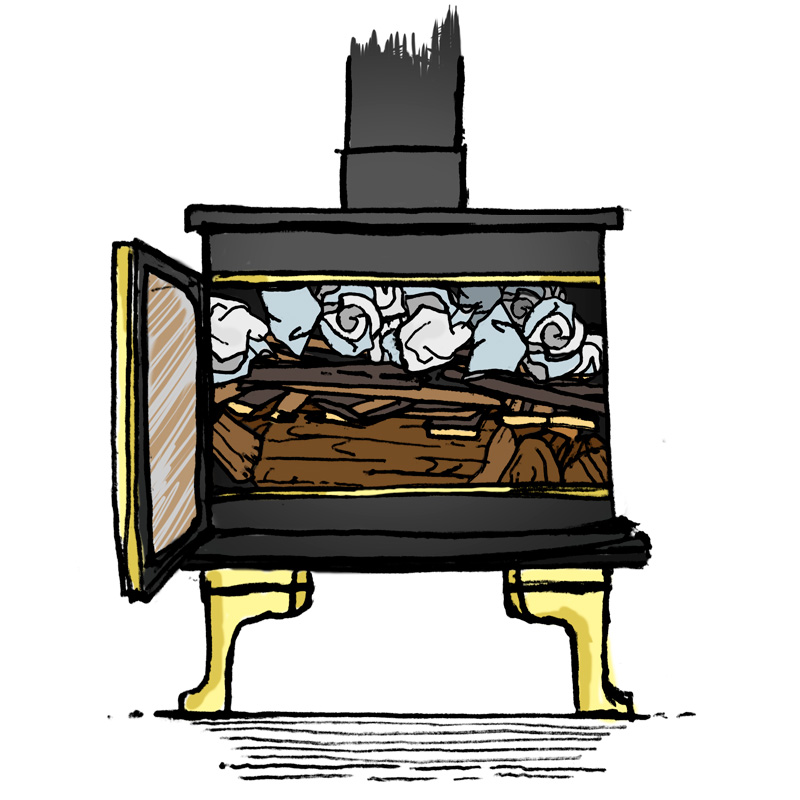 3. Light the paper. Be aware of the airflow, allowing the fire plenty of oxygen at first or it will die out. The fire will ‘grow’ down as the embers spread.
3. Light the paper. Be aware of the airflow, allowing the fire plenty of oxygen at first or it will die out. The fire will ‘grow’ down as the embers spread.
(Can we all take a moment to admire how incredibly talented my husband is? Yeah-he illustrated those pictures himself. Back off ladies. He’s mine ;))
The Science Behind an Upside Down Fire
It’s unconventional, but if you’ve followed my blog for long, you know that I relish a chance to defy social convention. After all, most of society is overweight & sick. So I choose not to eat like most of society. Just because something is common doesn’t mean it’s effective, efficient, or even correct!
Here’s why an upside down fire is cleaner and more efficient (in the words of the folks at the Dancing Rabbit, since I understand the concepts, but really, what’s the point of trying to reword something that’s already been communicated so clearly?)
“Complete combustion (no smoke) requires a pretty high temperature, much higher than the ignition temperature of wood. When you first light a fire, a lot of the energy released in combustion gets used up heating the rest of the wood in the fire-lay – energy that could otherwise be raising the temperature of the gases released in combustion and fully burning them off. In a bottom-up fire, the hot gases from the wood at the bottom of the lay move up through the stack and lose energy to the other pieces of wood. This cools off gases that would otherwise burn. That’s smoke – unburned gases. In the top-lit fire, those gases go straight up (just like in the bottom-lit fire) but now they don’t get cooled off by the other wood and are able to finish burning.
“The second main advantage, controlled pre-heating of wood, is pretty simple too. It’s related to the first one, in a way that’s probably obvious: since the gases aren’t giving up energy to heat the rest of the wood, the radiant energy heats the wood. So everything heats up more slowly, with fewer pockets of high temperature that could get combustion going in places we don’t want it starting yet, like at the bottom of the lay. Moisture is driven off in a more orderly way, the gases come off more slowly and encounter higher temperatures along the way, and the oxygen-to-fuel ratio stays much better than in a bottom-up scenario.
“The third advantage of the top-lit fire has to do with the ways wood burns at different temperatures. It’s a more complex overall concept, but here’s the essential point: having the coals form at the top of the fire ensures that they stay hot enough to release and burn all of their gases.”
Pros & Cons of an Upside Down Fire
The pros of building a fire upside down weigh out the cons hands down.
Pros:
- Faster combustion (less time sitting in front of it feeding it newspaper=a good thing)
- Uses less kindling & firewood
- Burns longer than ‘conventionally’ lit fires
- Requires less frequent ‘refueling’
- Less ash left in the stove
Con (if you can even call it that):
- Fire heats up more slowly (but once it gets hot, it stays hot longer)
This really does defy most fire-making logic, but that’s what I find so great about it! Upside down, inside out, backwards, and defying social convention. It’s pretty much how I live the rest of my life, so building a fire shouldn’t be any different ;)
Do you have a wood-burning stove? What fire-building techniques have worked best for you?
This post is linked to Simple Lives Thursday, Your Green Resource
Comments are closed.
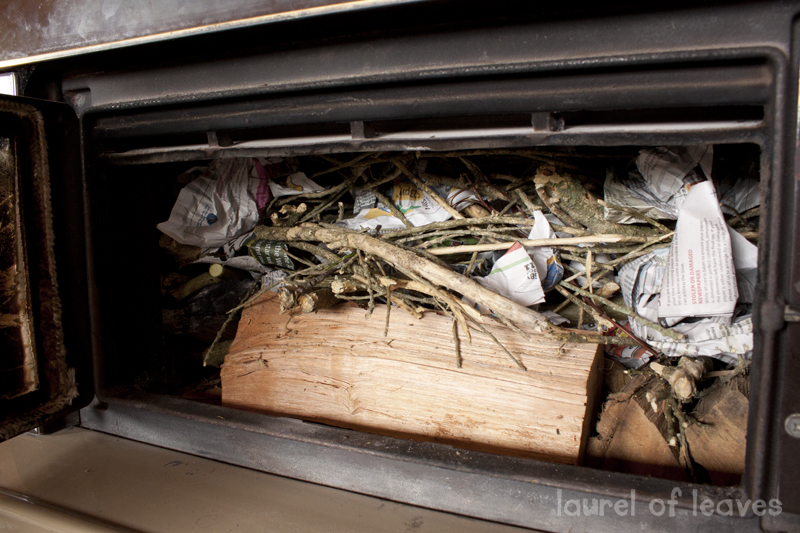
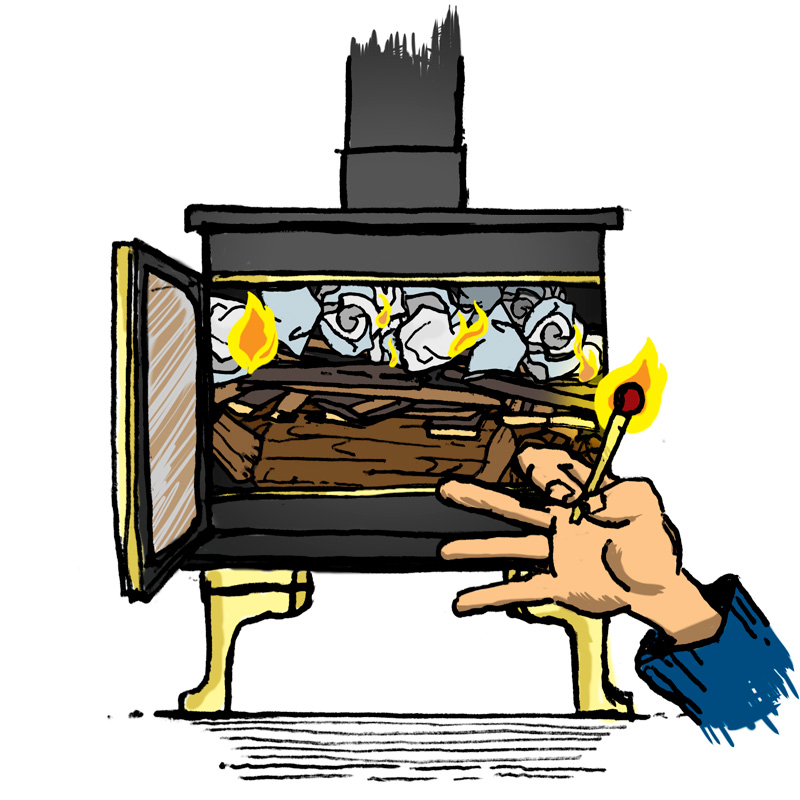
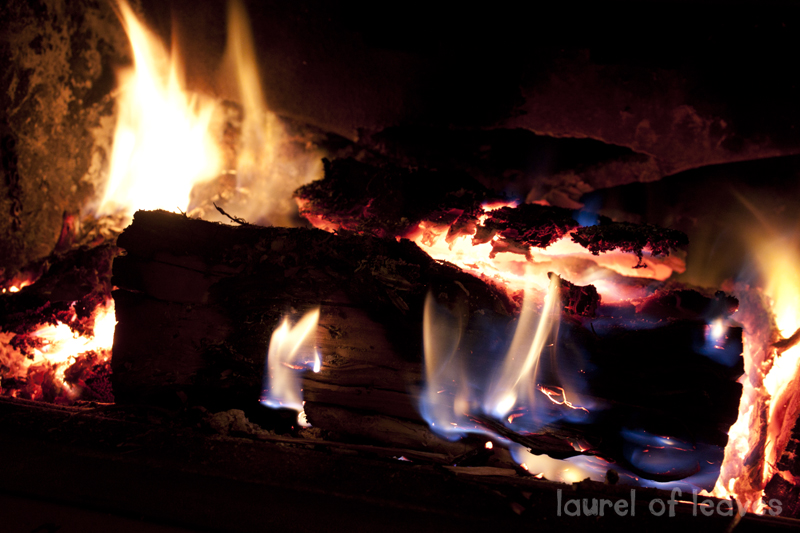
mare@just-making-noise
December 26, 2011 at 11:05 pmHey Chica! I’ll have to remember this. We are hoping to put in a wood burning stove in our house someday. But for now, we just bundle up… thankfully it doesn’t get below the 50s here ;o) Thanks for sharing!
Simply Life
December 27, 2011 at 5:14 pmwow! this is very creative- I would never think to do this!
Wendy (The Local Cook)
December 30, 2011 at 4:52 pmOooh thanks for posting this! I grew up with a wood furnace but now all we have is a small fireplace.
Camillia
January 9, 2012 at 1:42 amMy Opa (Dutch for grandfather) gave me the most important tip for a long burning fire – “wood in the fire always needs a buddy”. When you are banking the fire down to burn for a long period of time (like overnight) make sure there are at least two pieces of wood. Its something to do with air movement etc.. but all I know is that it works!
Lori Winter
January 9, 2012 at 1:17 pmThanks for the tip Camilla!
Stacy
January 13, 2012 at 5:32 pmAwesome! And wow, your hubby is talented. I love the illustrations. Will definitively try this out. I enjoy a good fire in our wood-burning stove.
I need to read more about your connection to New Zealand. I’ve been there once. It is beautiful. Hope to go back one of these days. Maybe on one of my trips back home (to Australia).
Lori Winter
January 13, 2012 at 5:39 pmThanks Stacy! We spent nine months traveling in New Zealand doing a help exchange. We worked for different host families doing permaculture gardening, cleaning, painting (whatever the families needed) in exchange for meals & accommodation. SUCH an amazing experience! You can check out our travel blog at http://www.thereandbackagain.me :)
Lori Winter
January 13, 2012 at 5:40 pmps–didn’t realize you were from Oz! Very cool :) What part of NZ did you visit when you were there?
Stacy
January 19, 2012 at 9:40 amI just took a look at your travel blog. How fun!
I have family in Christchurch, on the South Island.
I’ve only been to NZ once, but it was an adventure. My family traveled around the entire south island, camping somewhere new every few days. I was only in 6th grade at the time but still remember how stunning it was (and how we got stuck in the rain near a glacier. It was freezing!).
Your Green Resource – Week Seventeen | A Delightful Home
January 19, 2012 at 9:35 am[…] laurelofleaves.com via Stacy on […]
James
June 5, 2014 at 3:51 pmI burn my fires upside down as much as possible indoors and out.
Mass Rocket Stove designs are efficient and pretty much fail proof from what I have read. I’d like to build one by next winter.